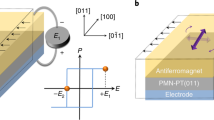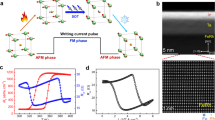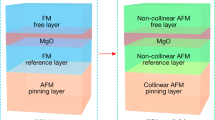Abstract
Spintronic devices based on antiferromagnetic (AFM) materials hold the promise of fast switching speeds and robustness against magnetic fields1,2,3. Different device concepts have been predicted4,5 and experimentally demonstrated, such as low-temperature AFM tunnel junctions that operate as spin-valves6, or room-temperature AFM memory, for which either thermal heating in combination with magnetic fields7 or Néel spin–orbit torque8 is used for the information writing process. On the other hand, piezoelectric materials were employed to control magnetism by electric fields in multiferroic heterostructures9,10,11,12, which suppresses Joule heating caused by switching currents and may enable low-energy-consuming electronic devices. Here, we combine the two material classes to explore changes in the resistance of the high-Néel-temperature antiferromagnet MnPt induced by piezoelectric strain. We find two non-volatile resistance states at room temperature and zero electric field that are stable in magnetic fields up to 60 T. Furthermore, the strain-induced resistance switching process is insensitive to magnetic fields. Integration in a tunnel junction can further amplify the electroresistance. The tunnelling anisotropic magnetoresistance reaches ~11.2% at room temperature. Overall, we demonstrate a piezoelectric, strain-controlled AFM memory that is fully operational in strong magnetic fields and has the potential for low-energy and high-density memory applications.
This is a preview of subscription content, access via your institution
Access options
Access Nature and 54 other Nature Portfolio journals
Get Nature+, our best-value online-access subscription
$29.99 / 30 days
cancel any time
Subscribe to this journal
Receive 12 print issues and online access
$259.00 per year
only $21.58 per issue
Buy this article
- Purchase on Springer Link
- Instant access to full article PDF
Prices may be subject to local taxes which are calculated during checkout





Similar content being viewed by others
Data availability
The data that support plots within this paper and other findings of this study are available from the corresponding author upon reasonable request.
References
MacDonald, A. H. & Tsoi, M. Antiferromagnetic metal spintronics. Phil. Trans. R. Soc. A 369, 3098–3114 (2011).
Jungwirth, T., Marti, X., Wadley, P. & Wunderlich, J. Antiferromagnetic spintronics. Nat. Nanotech. 11, 231–241 (2016).
Baltz, V. et al. Antiferromagnetic spintronics. Rev. Mod. Phys. 90, 015005 (2018).
Núñez, A. S., Duine, R. A., Haney, P. & MacDonald, A. H. Theory of spin torques and giant magnetoresistance in antiferromagnetic metals. Phys. Rev. B 73, 214426 (2006).
Gomonay, H. V. & Loktev, V. M. Spin transfer and current-induced switching in antiferromagnets. Phys. Rev. B 81, 144427 (2010).
Park, B. G. et al. A spin-valve-like magnetoresistance of an antiferromagnet-based tunnel junction. Nat. Mater. 10, 347–351 (2011).
Marti, X. et al. Room-temperature antiferromagnetic memory resistor. Nat. Mater. 13, 367–374 (2014).
Wadley, P. et al. Electrical switching of an antiferromagnet. Science 351, 587–590 (2016).
Ramesh, R. & Spaldin, N. A. Multiferroics: progress and prospects in thin films. Nat. Mater. 6, 21–29 (2007).
Matsukura, F., Tokura, Y. & Ohno, H. Control of magnetism by electric fields. Nat. Nanotech. 10, 209–220 (2015).
Xu, M. et al. Progresses of magnetoelectric composite films based on PbMg1/3Nb2/3O3-PbTiO3 single-crystal substrates. Acta Phys. Sin 67, 157506 (2018).
Feng, Z. X., Yan, H. & Liu, Z. Q. Electric-field control of magnetic order: from FeRh to topological antiferromagnetic spintronics. Adv. Electron. Mater. https://doi.org/10.1002/aelm.201800466 (2018).
Krén, E. et al. Magnetic structures and exchange interactions in the Mn–Pt system. Phys. Rev. 171, 574–585 (1968).
Farrow, R. F. C. et al. MnxPt1-x: a new exchange bias material for permalloy. J. Appl. Phys. 81, 4986–4988 (1997).
Coey, J. M. D. Magnetism and Magnetic Materials (Cambridge Univ. Press, Cambridge, 2009).
Chen, Z. H. et al. Electron accumulation and emergent magnetism in LaMnO3/SrTiO3 heterostructures. Phys. Rev. Lett. 119, 156801 (2017).
Umetsu, R. Y., Fukamichi, K. & Sakuma, A. Electrical and magnetic properties, and electronic structures of pseudo-gap-type antiferromagnetic L10-type MnPt alloys. Mater. Trans. 47, 2–10 (2006).
Liu, Z. Q. et al. Full electroresistance modulation in a mixed-phase metallic alloy. Phys. Rev. Lett. 116, 097203 (2016).
Zhang, S. et al. Electric-field control of nonvolatile magnetization in Co40Fe40B20/Pb(Mg1/3Nb2/3)0.7Ti0.3O3 structure at room temperature. Phys. Rev. Lett. 108, 137203 (2012).
Yang, L. et al. Bipolar loop-like non-volatile strain in the (001)-oriented Pb(Mg1/3Nb2/3)O3-PbTiO3 single crystals. Sci. Rep. 4, 4591 (2014).
Wu, T. et al. Domain engineered switchable strain states in ferroelectric (011) [Pb(Mg1/3Nb2/3)O3](1-x)-[PbTiO3]x (PMN-PT, x≈0.32) single crystals. J. Appl. Phys. 109, 124101 (2011).
Biegalski, M. D., Dörr, K., Kim, D. H. & Christen, H. M. Applying uniform reversible strain to epitaxial oxide films. Appl. Phys. Lett. 96, 151905 (2010).
Hochstrat, A., Binek, C., Chen, X. & Kleemann, W. Extrinsic control of the exchange bias. J. Magn. Magn. Mater. 272–276, 325–326 (2004).
He, X. et al. Robust isothermal electric control of exchange bias at room temperature. Nat. Mater. 9, 579–585 (2010).
Polisetty, S. et al. Piezoelectric tuning of exchange bias in a BaTiO3/Co/CoO heterostructure. Phys. Rev. B 82, 134419 (2010).
Liu, Z. Q. et al. Epitaxial growth of intermetallic MnPt films on oxides and large exchange bias. Adv. Mater. 28, 118–123 (2016).
Hama, H., Motomura, R., Shinozaki, T. & Tsunoda, Y. Spin–flip transition of L10-type MnPt alloy single crystal studied by neutron scattering. J. Phys. Condens. Matter 19, 176228 (2007).
Liu, Z. Q. et al. Electrically reversible cracks in an intermetallic film controlled by an electric field. Nat. Commun. 9, 41 (2018).
Lee, Y. et al. Large resistivity modulation in mixed-phase metallic systems. Nat. Commun. 6, 5959 (2015).
Chen, H., Niu, Q. & MacDonald, A. H. Anomalous Hall effect arising from noncollinear antiferromagnetism. Phys. Rev. Lett. 112, 017205 (2014).
Liu, Z. Q. et al. Electrical switching of the topological anomalous Hall effect in a non-collinear antiferromagnet above room temperature. Nat. Electron. 1, 172–177 (2018).
Kuroda, K. et al. Evidence for magnetic Weyl fermions in a correlated metal. Nat. Mater. 16, 1090–1095 (2017).
Acknowledgements
Zhiqi L. acknowledges financial support from the National Natural Science Foundation of China (NSFC; grant numbers 51822101, 51771009 and 11704018). Z.Z. and Zhiqi L. acknowledge financial support from the NSFC on the Science Foundation Ireland–NSFC Partnership Programme (NSFC grant number 51861135104). S.S. and Zikui L. acknowledge financial support from the US Department of Energy (award number DE-FE0031553). M.C. acknowledges support from Science Foundation Ireland contract 12/RC/2278. Z.C. acknowledges the NSFC (number 51802057) and a startup grant from the Harbin Institute of Technology (Shenzhen, China), under project number DD45001017. The Advanced Light Source is supported by the Director, Office of Science, Office of Basic Energy Sciences, of the US DOE under contract DE-AC02-05CH11231.
Author information
Authors and Affiliations
Contributions
H.Y. and Z.F. performed the sample growth, electrical and magnetic measurements, with assistance from X.W., Z.H., H.H., W.L., Jingmin W., P.Q., H.G., X.Z., Z. Leng and C.J. Zhiqi L. performed the XRD measurements. Z.C. performed the X-ray absorption spectroscopy and X-ray magnetic circular dichroism measurements. H.W. performed the TEM measurements. Jinhua W. and Z.Z. performed the high magnetic field measurements. S.S. and Zikui L. performed the theoretical calculations. Zhiqi L. wrote the manuscript, along with H.Y., Z.F., X.W., Z.H. and M.C. All authors discussed the results and commented on the manuscript. Zhiqi L. conceived and led the project.
Corresponding author
Ethics declarations
Competing interests
The authors declare no competing interests.
Additional information
Publisher’s note: Springer Nature remains neutral with regard to jurisdictional claims in published maps and institutional affiliations.
Supplementary information
Supplementary Information
Supplementary Figures 1–8
Rights and permissions
About this article
Cite this article
Yan, H., Feng, Z., Shang, S. et al. A piezoelectric, strain-controlled antiferromagnetic memory insensitive to magnetic fields. Nature Nanotech 14, 131–136 (2019). https://doi.org/10.1038/s41565-018-0339-0
Received:
Accepted:
Published:
Issue Date:
DOI: https://doi.org/10.1038/s41565-018-0339-0
This article is cited by
-
Room-temperature ferromagnetism and piezoelectricity in metal-free 2D semiconductor crystalline carbon nitride
Nano Research (2024)
-
Experimental demonstration of a skyrmion-enhanced strain-mediated physical reservoir computing system
Nature Communications (2023)
-
Coherent antiferromagnetic spintronics
Nature Materials (2023)
-
Room-temperature magnetoresistance in an all-antiferromagnetic tunnel junction
Nature (2023)
-
Recent development of E-field control of interfacial magnetism in multiferroic heterostructures
Nano Research (2023)



